Triads are an integral music concept for guitar and all other musical instruments. Whether you’re creating chords, arpeggios, or building great solos and improvisations, triads are an important step in leveling up your guitar playing. Guitar triads are fairly easy to memorize, and the shapes are easy to play.
💡In this lesson, you’ll learn what triads are, how guitar triads look, how to use them in a Major Key using Major, minor, and diminished triads.
Last month Thomas, one of my email readers requested a more in-depth lesson on guitar triads. Although I had touched on the subject in my Beginner Chord Guide (as well as the 7 Day Practice Routine).. maybe a refresher lesson, or perhaps a different approach on triads was worth a look. Let’s get to it!
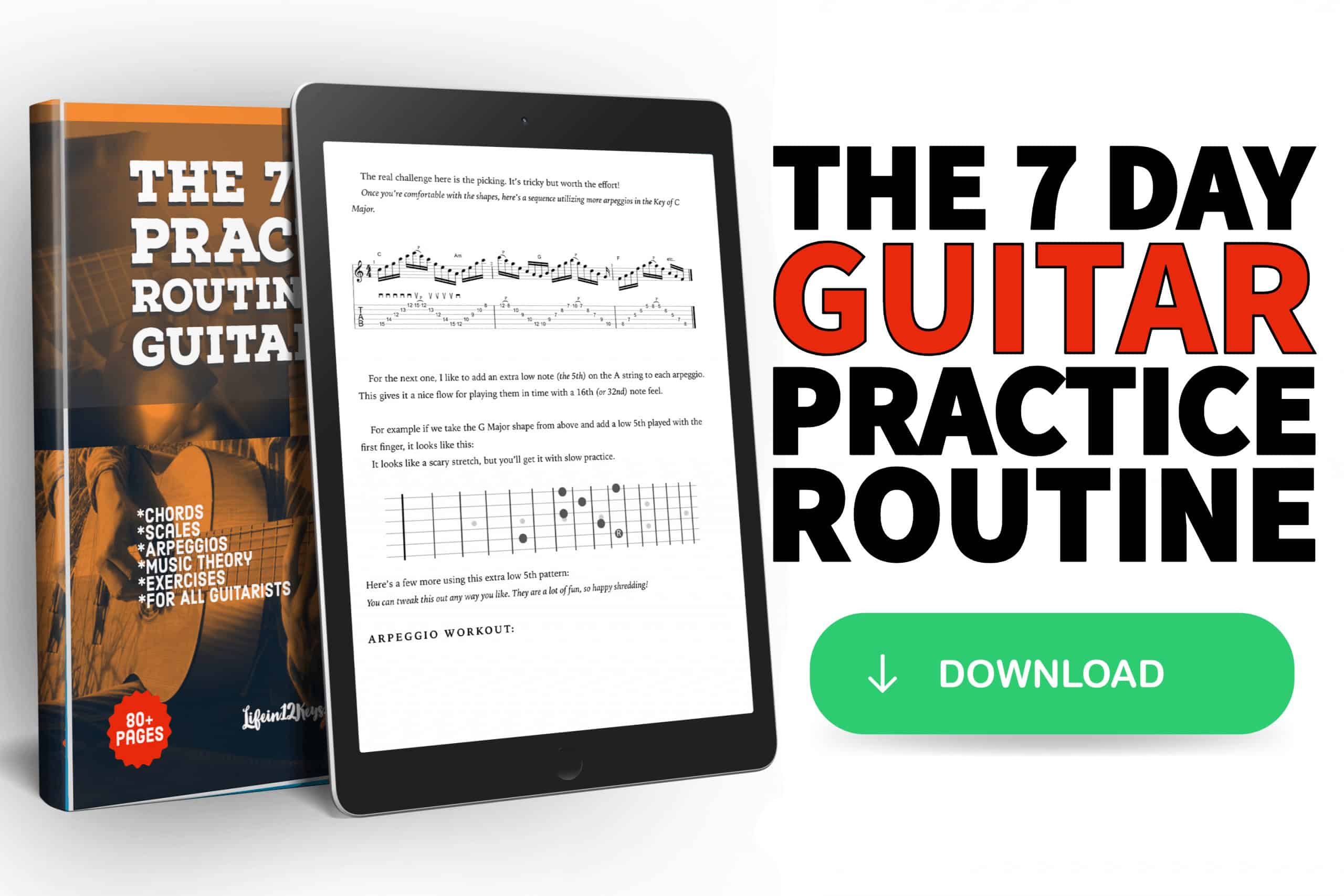
Table of Contents
In this lesson we’re going to learn triads for guitar using Major, minor, diminished, and Augmented shapes. I like to teach triads in the context of a whole key, so in this case we’ll use the key of C Major:
C D E F G A B C
If we stay only in this C Major Scale and build (1-3-5) diatonic triads off of every scale degree, we get the following chart.
| Note | C E G | D F A | E G B | F A C | G B D | A C E | B D F |
| Enharmonic | R-3-5th | R-♭3-5 | R-♭3-5 | R-3-5 | R-3-5 | R-♭3-5 | R-♭3-♭5 |
Building a triad off of each scale tone looks like this:
Triads Key of C Major

Don’t worry if you can’t read music. Just visualize the triad structure on the lines and spaces. I think it’s important to learn triads for the guitar this way rather than just memorizing a bunch of information and music theory. Why?
💡When you learn Triads functionally rather theoretically it gives you an actionable practice framework from which to build ideas for guitar solos, songs, melodies, and improvisations. You will gain a better understand of the many things you can play within a key without hitting any “bad” notes. Let’s take a look at the first grouping.
C Major Guitar Triads
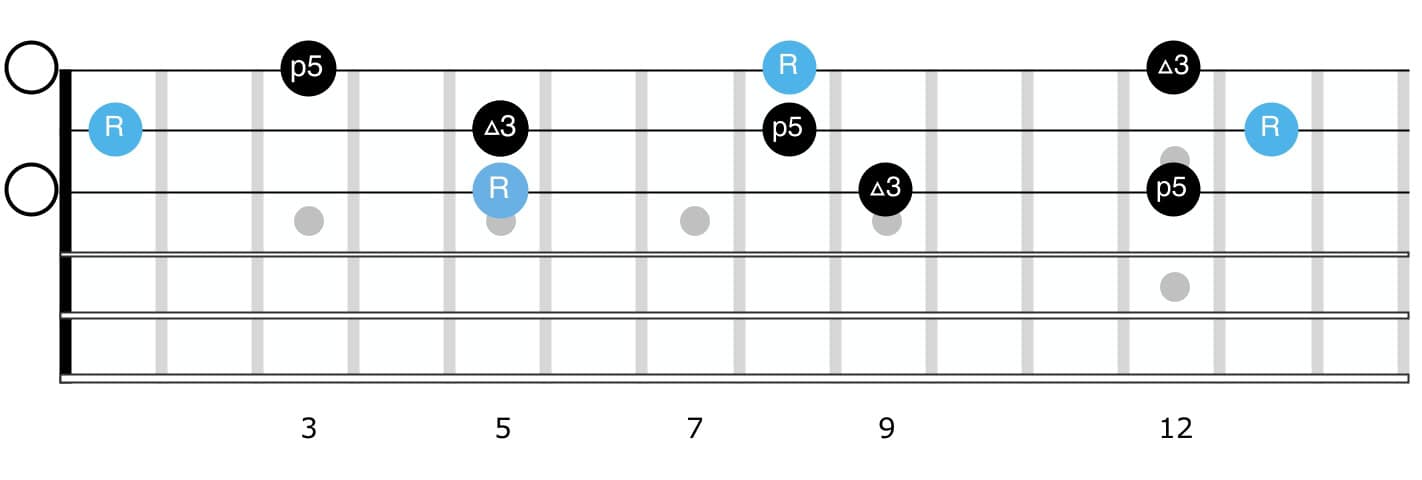
Most guitarists won’t have much trouble reading these fretboard charts, but if you’re a beginner that’s ok! If you get it, go ahead and move on.
This is a horizontal guitar fretboard as if you were looking down on it while playing.
- The Low E String is on the bottom (thickest string).
- On the top is the highest string (High E).
- The frets are the light gray vertical lines.
- The Circles are the notes in the Triads.
- R = Root or 1st Degree.
- ▵3 = Major 3rd.
- ♭3 = Lowered 3rd (minor).
- P5 = Perfect or Major 5th
- ♯5 = Sharp 5th, or Raised 5th degree (Augmented).
- ♭5 = Flat 5th or lowered 5th degree (diminished).
Triad Inversions
In Ex. 1 we have triads built from the root C on the top 3 strings G, B, and E. Seems simple enough right? Don’t overthink it. This is how all chords and arpeggios are built in every key or scale
What if you flip the notes around? Instead of C E G, you play E G C? Is it still a C Major triad?

Yep, it’s just a different inversion.
In Ex.1 The 3rd fret position grouping (C E G) includes the notes in scale degree order 1-3-5.
The next grouping shows the Major (▵) 3rd in the bass, or First Inversion.
The last grouping shows the Perfect (P) 5th in the bass, or 2nd Inversion.
The best part about these shapes is that we only need to learn 3 different forms on each string grouping.
C Maj Triads
In Ex. 2 we’re using the same notes (C-E-G), but shifting down to the next set of strings.
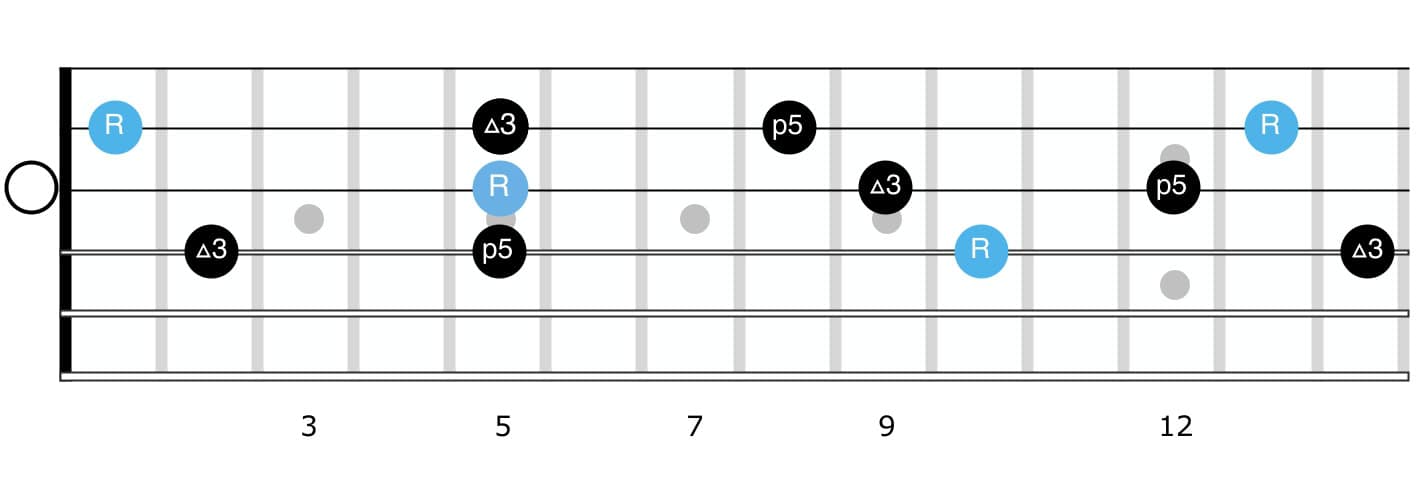
In Ex. 2 above, we get some new shapes and triad inversions on the next set of adjacent strings B, G, and D.
Triad Types
From left to right the inversions are:
- 1st Inversion
- 2nd Inversion
- C Major Triad
- 1st Inversion 1 octave higher.
In Ex. 3. We can continue moving to the next set of strings A – D – G and grab some new shapes using the same 3 notes.
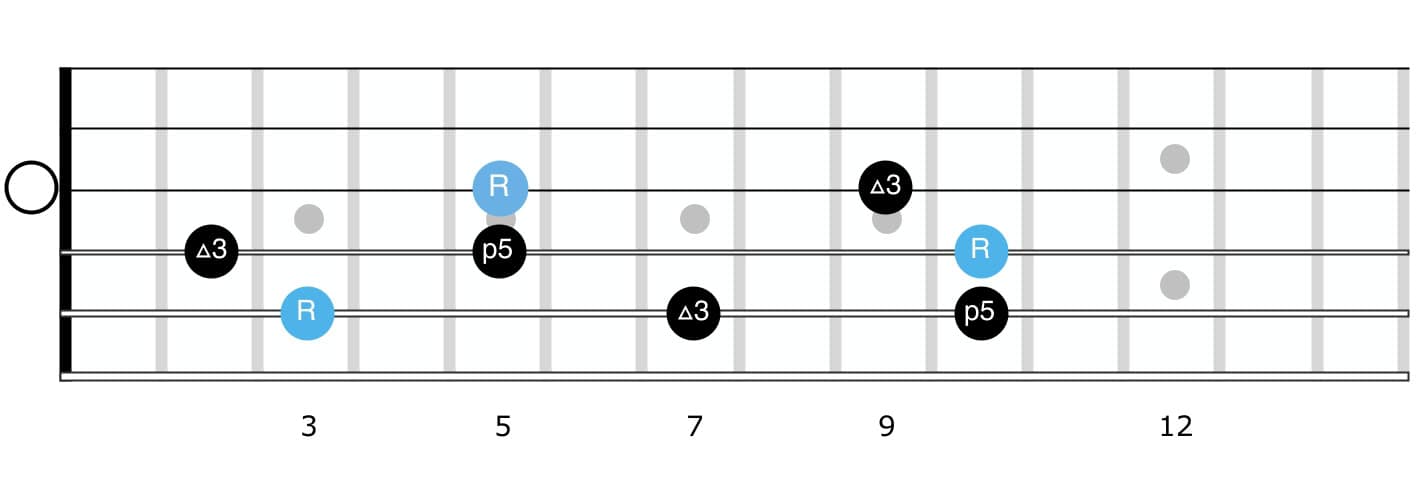
In Example 4., we get the last string grouping of Major Triads on the low E, A, and D strings for the root C. You don’t have to learn new triad shapes for the other Major triads in the key. You can just move the root note to whichever triad you’re looking for. If were in the Key of C, we’ll have 3 Major Triad – Chord – Arpeggios:
- C Major
- F Major
- G Major
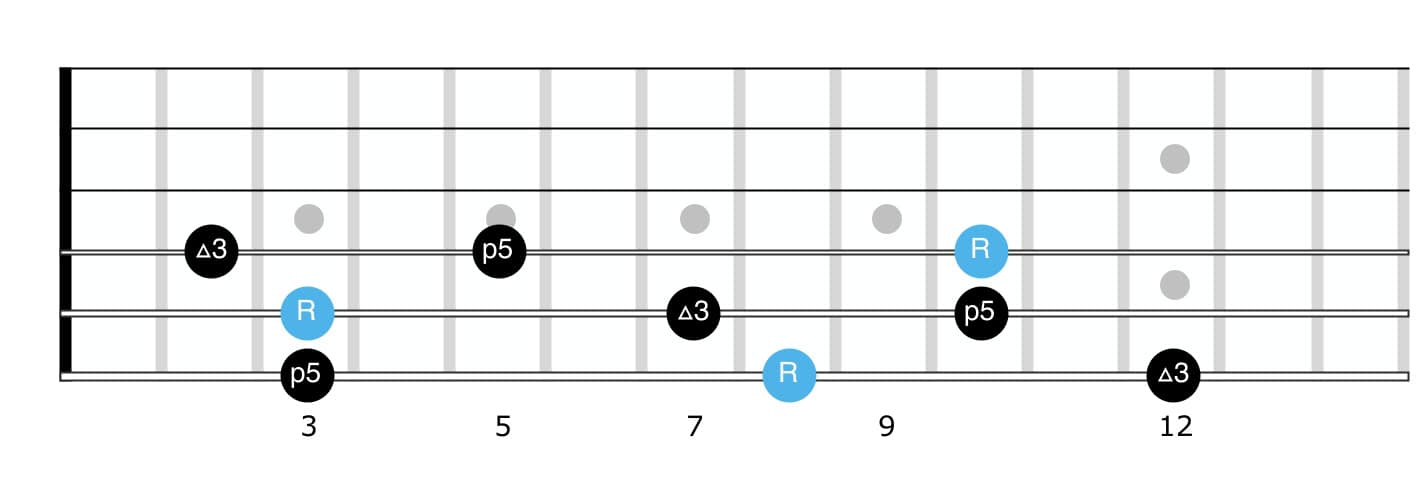
Keep in mind, there are only 3 types of triads in every Major Key. We can also call these Diatonic Triads as they follow the Key Signature of the scale we are playing in without any deviation. We are just building a new Triad on each scale degree.
Minor Triad Guitar Shapes
The second type of triad we’ll see diatonically in any Major Key is the minor triad. Remember, minor triads contain the Root, ♭3rd, and P5th. For our next set D minor, those notes would be D F A.
Now lets move on the the second group of triads in the Key of C Major: D minor. As we did with the C Major triads, we’re going to make our D minor triads on 4 different adjacent string groupings.
D minor Guitar Triads
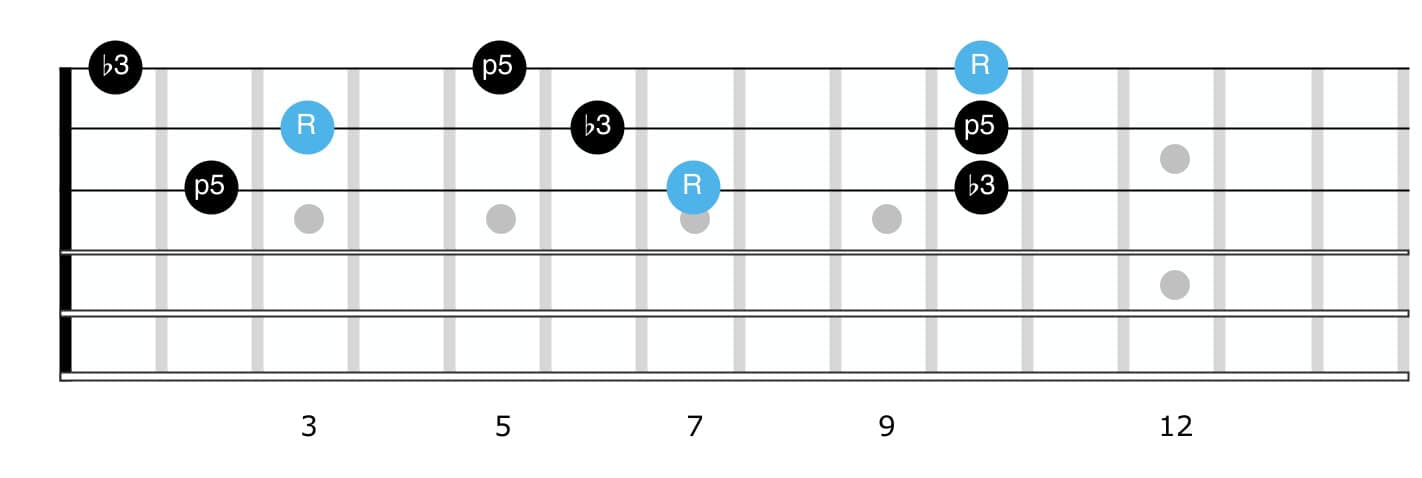
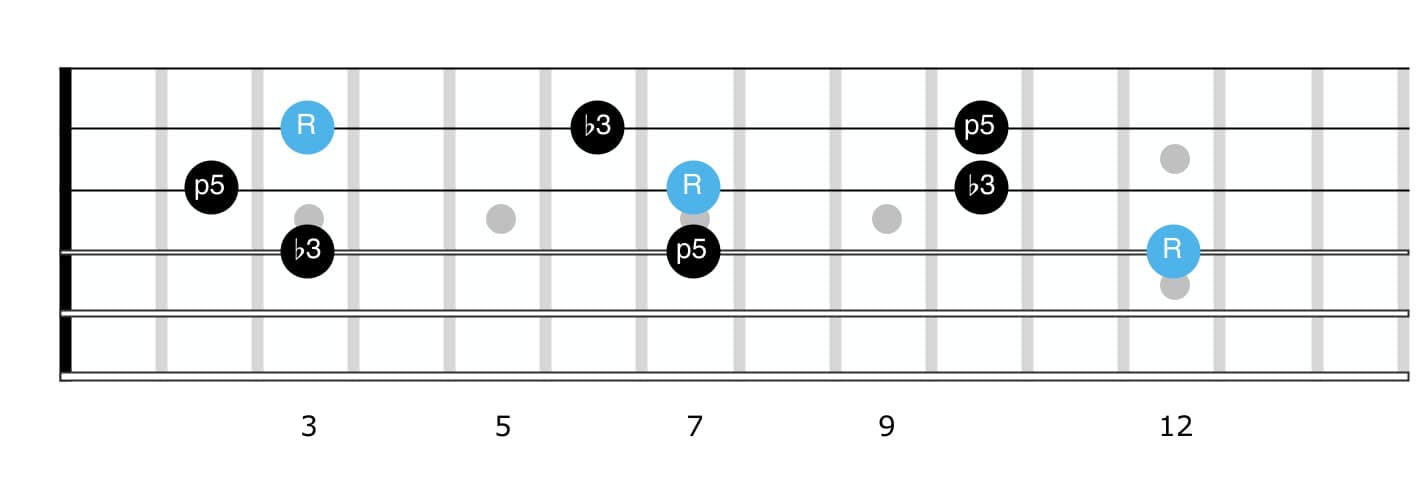
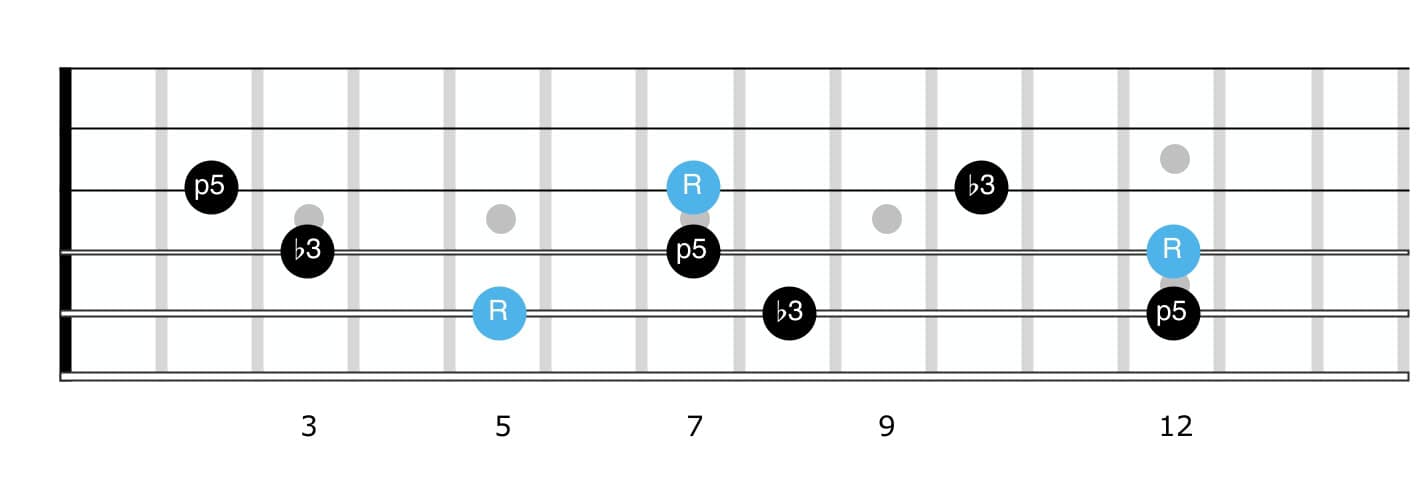
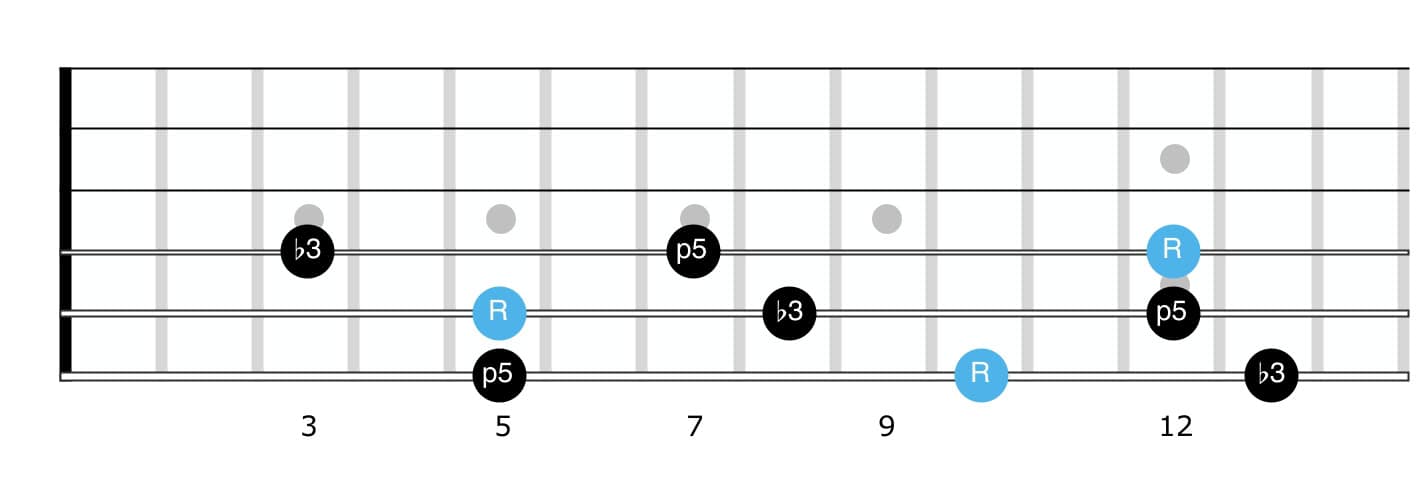
Triads Guitar PDF
Viewing this lesson on a website can be a little awkward depending on your screen size, so I’ve also included an awesome printable PDF triads chart eBook. This 30 page book is free for a limited time, so grab the instant download now:
You may be wondering if there are more triad shapes on guitar? YES, there are many combinations of triads once you factor in skipping strings and longer fret reaches. Try experimenting and practice finding the 3 notes in each triad on different strings. I’ve also included a master note list at the end of this lesson to help make it easier.
Try using backing tracks (more on this later) in the Key of C Major and find the target notes.
Other Types of Guitar Triads
In Guitar and all music, there are 4 types of triads that chords (and arpeggios) are built from:
- Major -Includes the Root, Major (▵3rd), and Perfect (P5) 5th.=
- Minor – Includes the Root, flat or (♭3) 3rd and Perfect 5th.
- Augmented – Just adds a raised or ♯5th to a Major triad, or R, 3, ♯5.
- Diminished – a minor triad with a ♭5th. R, ♭3, ♭5.
Notice in the table of C triads earlier, there are no Augmented Triads listed for any of the notes in the key of C Major. Incidentally, adding the raised ♯5th not to any of the triads will take us out of key. For example a C augmented triad would include the Root, ▵3, and ♯5 or C- E – G#.
This G♯ note takes us out of the key and is not included. The same would happen for all of the other triads in the if we added that ♯5.
For more on Key Signatures and how the notes in the scales work together, check out my free online guitar lesson on the Circle of Keys and scale theory for guitar.
Augmented Triads
Augmented Triad guitar patterns, (R – ▵3 – ♯5), even though they go out of key, are still worth learning on guitar. They have a really neat repeating symmetrical pattern which makes them easy to learn, memorize, and move around.
💡Remember that just because a chord, scale, or arpeggio goes out of key doesn’t make it any less useful. It may have a specific sound or transition to another chord or sound that goes back in key.
Augmented triads & chords have been widely used in virtually every type of music from Bach to The Beatles and are certainly worth your time in the guitar practice room.
Let’s check out some Augmented Triad groups using C as our Root note: Notice how Augmented Triad Guitar patterns repeat on the neck. Pretty cool right? Think of it as an A minor chord shape that moves in Major 3rds or 2 whole-steps.
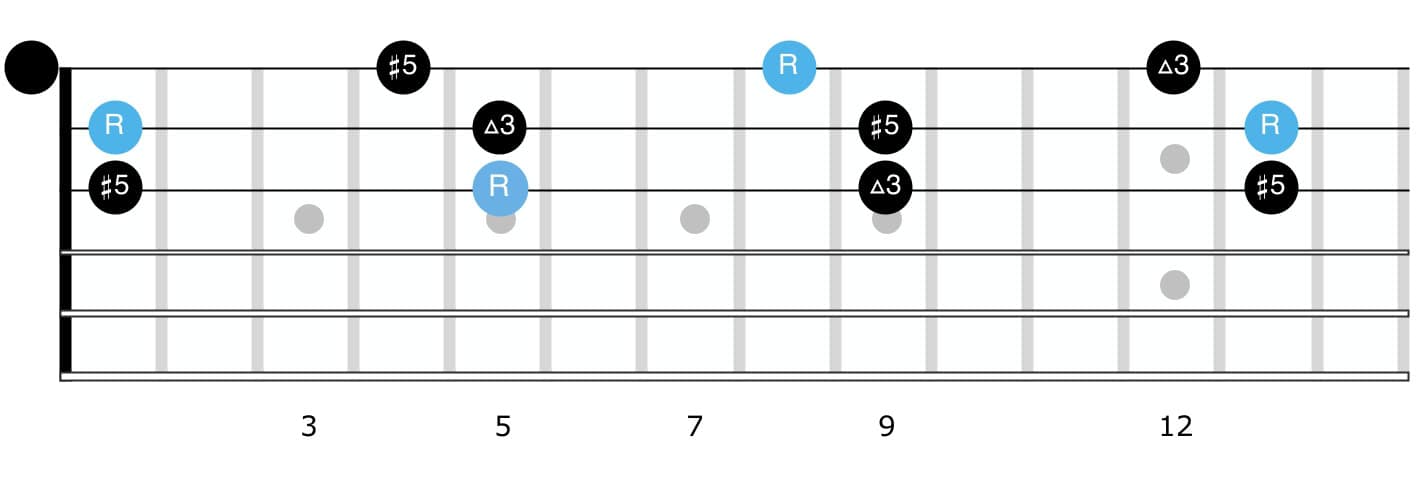
C Augmented Guitar Triads
Let’s move on to the next sets of strings for our remaining patterns.
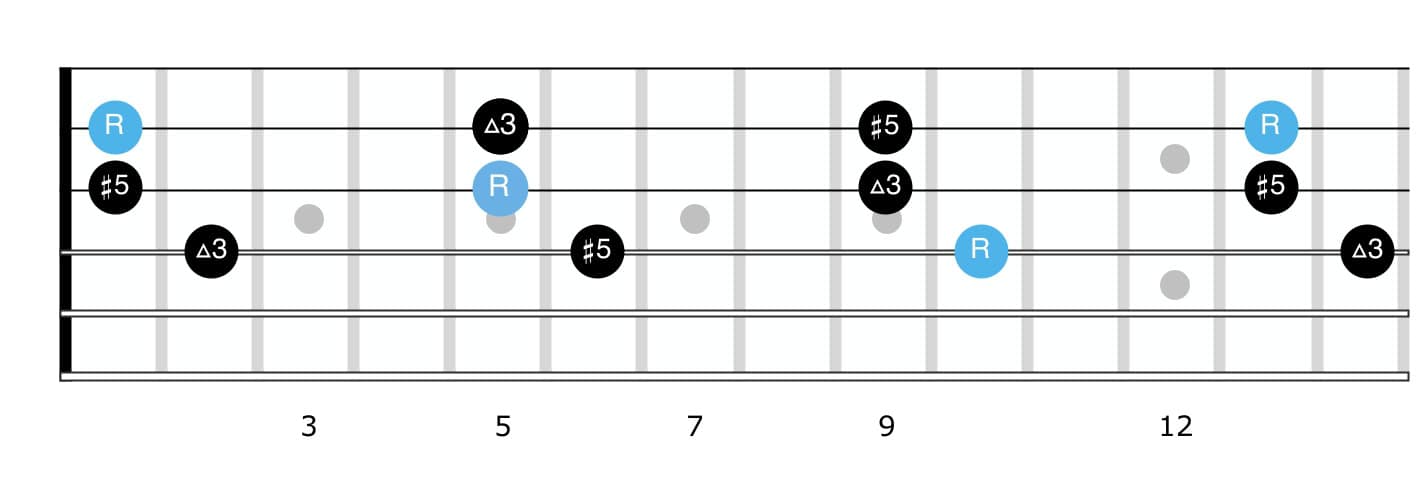
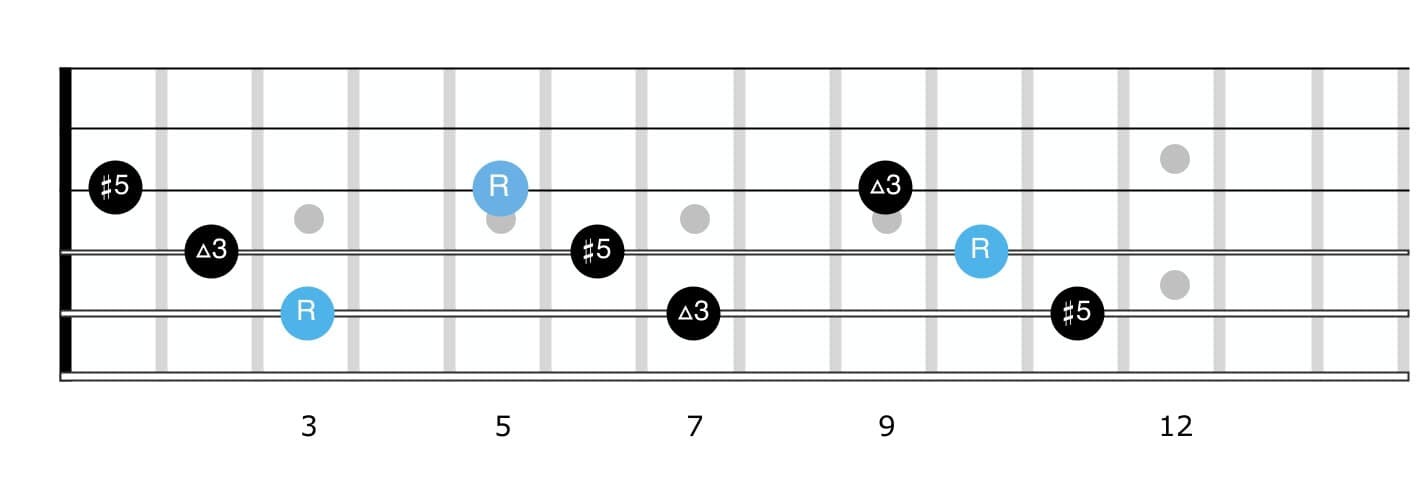
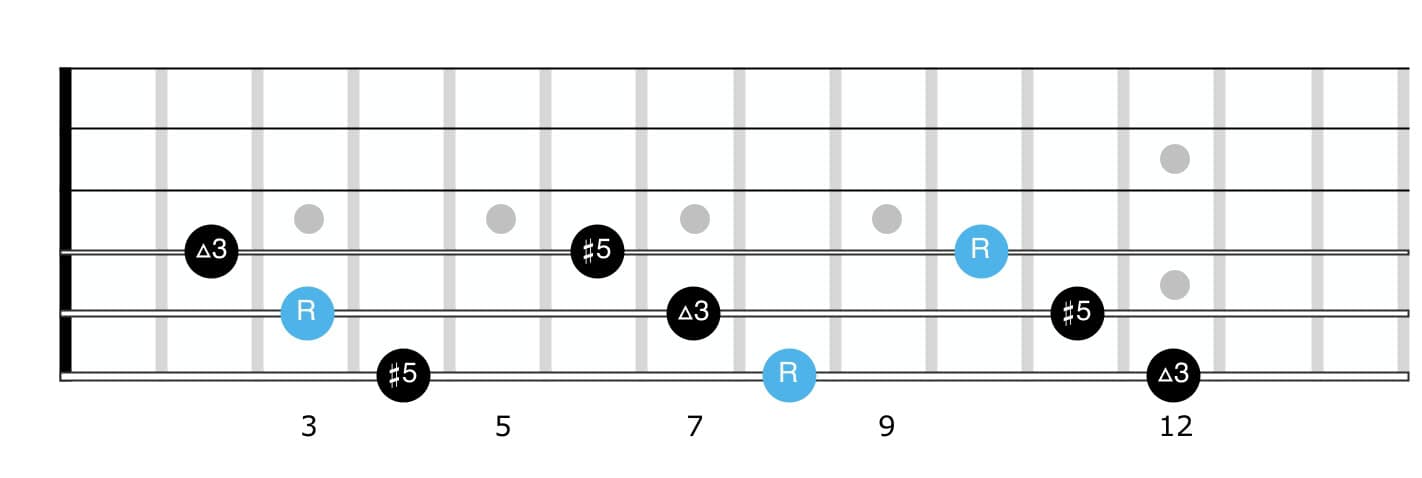
Now that we’ve covered Major Triads and Augmented Triads, lets take a look at strictly diatonic triads in the key of C.
The next triad in the Key of C is the E minor triad. E – G – B or (R ♭3 5)
Minor Triads
We can build minor triads on the 2nd, 3rd, and 6th degrees of every Major scale. In the Key of C this gives us 3 minor Triads, Chords, and Arpeggios:

C D E F G A B C
- D minor (D F A)
- E minor (E G B)
- A minor (A C E)
Remember: These triad formulas are the exact same notes that make up our chords and arpeggios!
Let’s map out our triad shapes on the guitar fretboard for E minor.
E Minor Guitar Triads
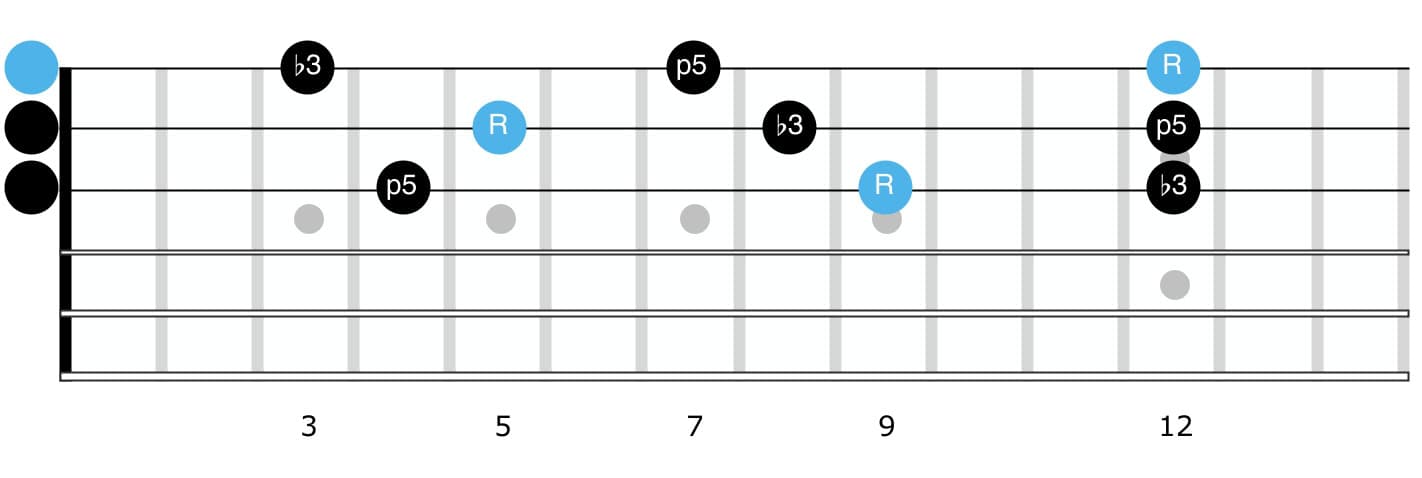
Notice the triad shapes for E minor are the exact same as the triads for D minor. The only difference is where the root notes lie on the guitar neck.
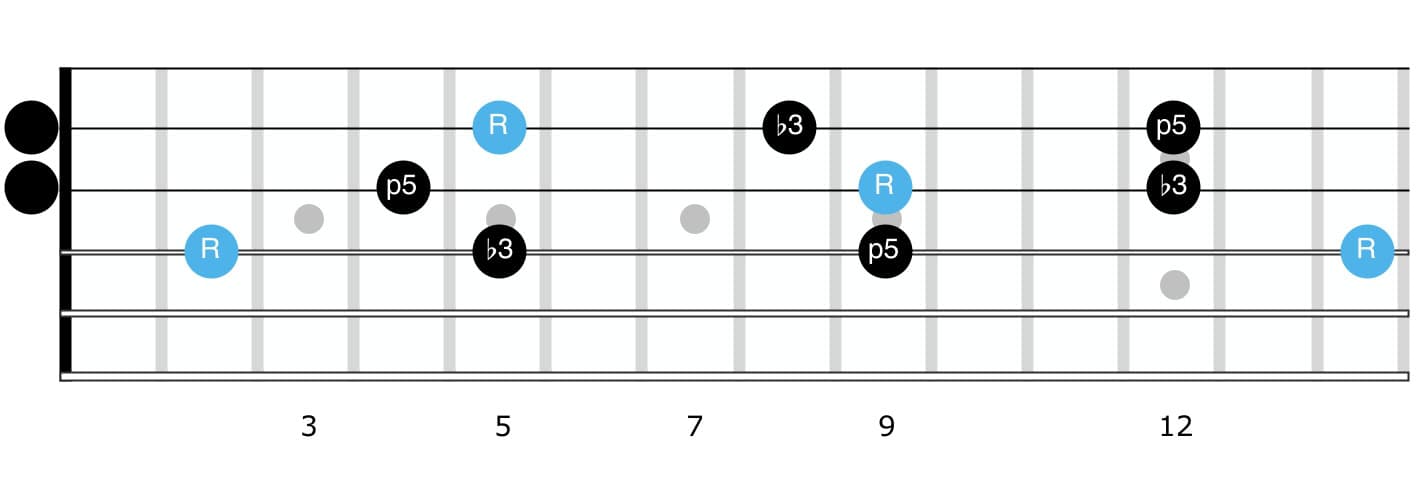

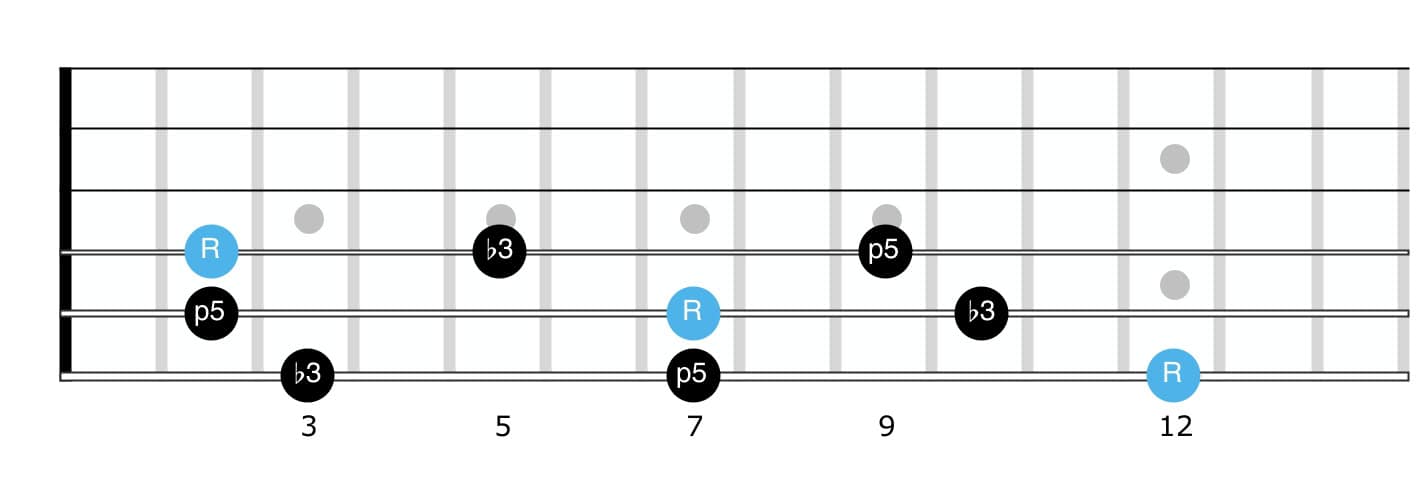
How to Practice Triads on Guitar
Before moving on to the rest of our triads in the key, lets take a little break and talk about some different ways we can practice these on the guitar. Learning a bunch of similar shapes can get boring real fast unless you can find a way to incorporate this stuff into your everyday guitar playing.
I like to work with Triads in a few different ways:
- Picking Exercises.
- Solo & Improvisation over backing tracks (or looper).
Improvising with Triads on Guitar
One of the easiest and best ways to get triads under your fingers is by using them in real-world playing situations such as improvising and soloing. Regardless of your skill level, targeting specific notes from triads is a great way to build melodies, create licks, and hit all of the good notes in a guitar solo.
Grab a C Major Backing track from Youtube. There are all different styles from Acoustic, to Heavy Metal. Pick whatever you like or create a playlist of different styles.
Cycle through each triad shape from previous examples slowly and see how they sound over the different chords in the key of C. Once you get a few shapes memorized, try to hit the specific triad over the chord as it passes by. For example, In a C- Dm -C progression, when a D minor chord comes up, switch to those D minor triad shapes.
If you don’t have YouTube or something suitable in your guitar practice area, use a looper and record yourself playing the chords in the key of C however you like.
If you’re a beginner and need some chords, grab my Complete Chord Guide or check out some of the other lessons on the website.
Picking Exercises Using Triads
A while back I wrote this next exercise using the triads from one of J.S. Bach’s famous piano inventions. Bach wrote so many amazing pieces that translate really nicely to acoustic, electric, and of course; Classical Guitar.
This little section from a Prelude in A minor uses only the top three strings and a variety of different alternate picking combinations. Great for both hands, but particularly effective for developing a strong cross-picking technique. Definitely a little more advanced, but really fun!
Major Triads
Earlier we discussed the C Major and Augmented type triads for guitar. Just a quick reminder: Major Triads contain the Root or 1st degree of the scale, Major 3rd (or ▵3), and 5th or Perfect 5th (P5). In. The key of C Major this as in every Major scale key we get 3 Major triads:
- C Major – C – E – G
- F Major – F – A – C
- G Major – G- B – D

Major triads will always fall on the 1st, 4th, and 5th degrees of the Major Key.
Let’s continue to our next Major triad set: F Major
F Major Guitar Triads
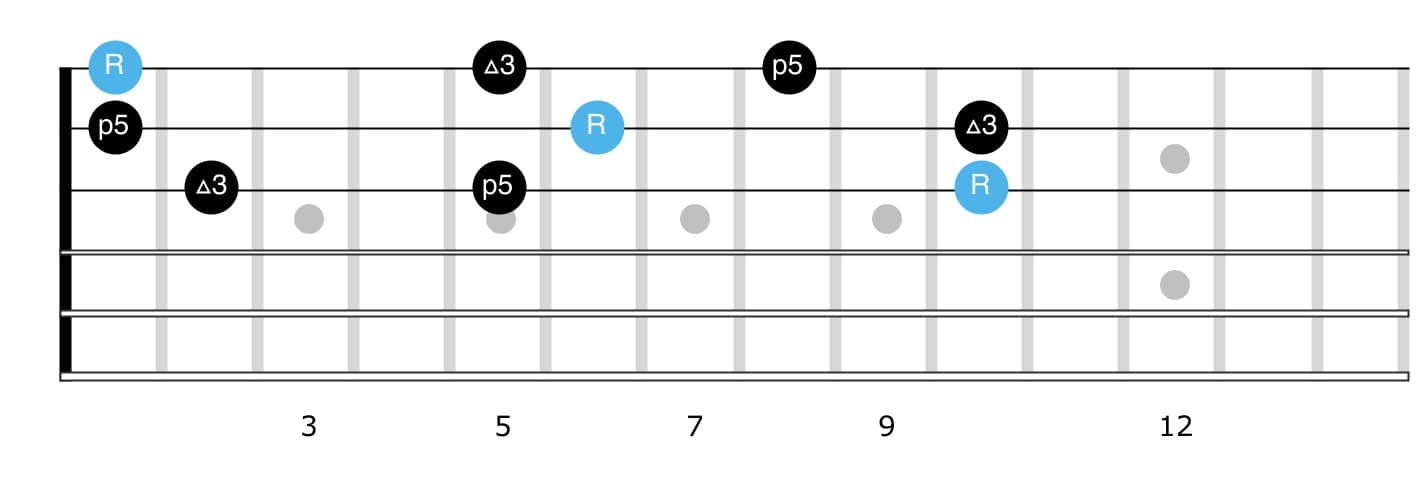
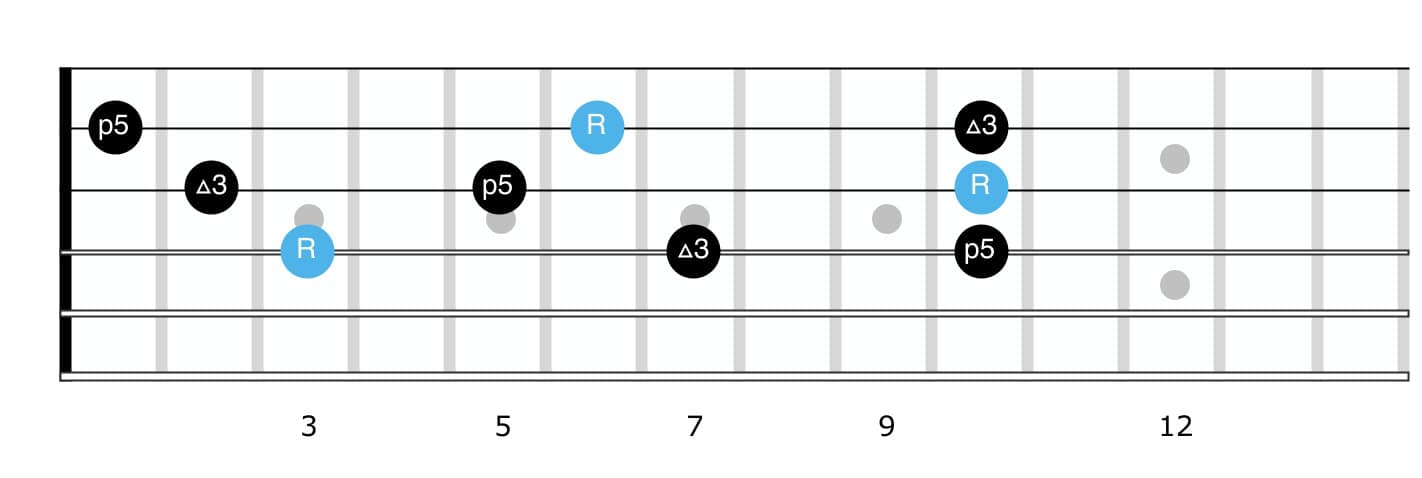
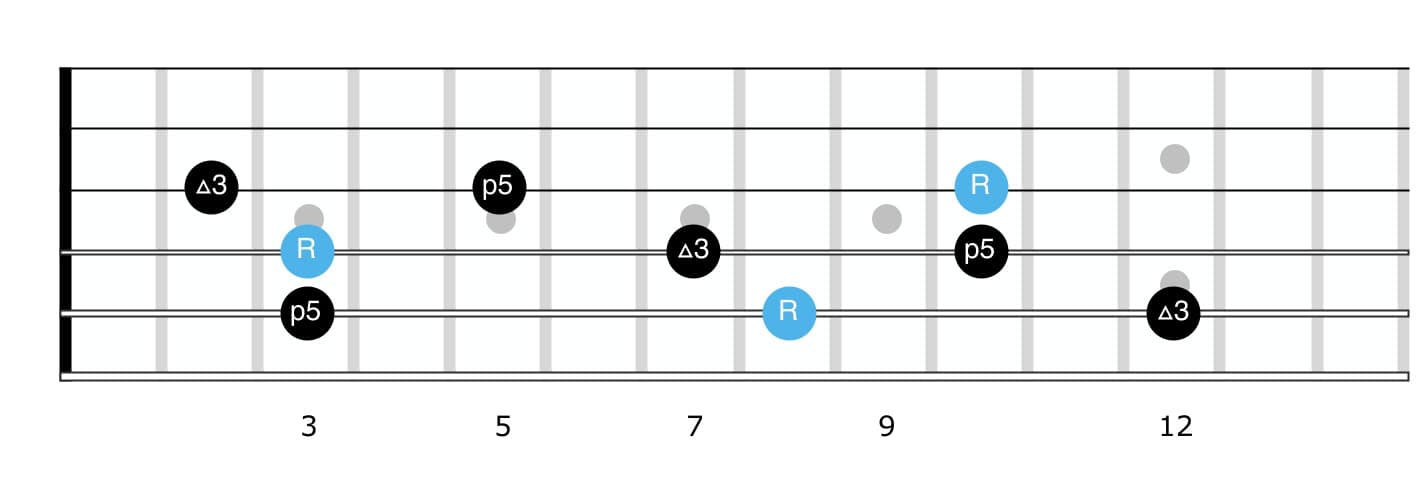
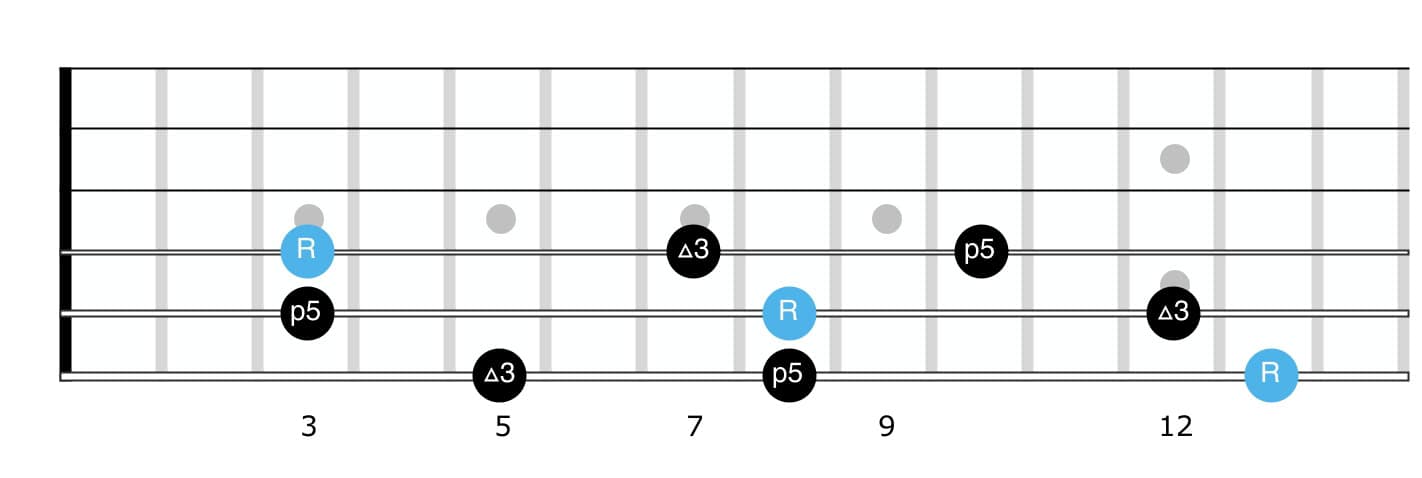
The next and last Major triad group in the Key of C is the G Major triad.
G Major Triads for Guitar
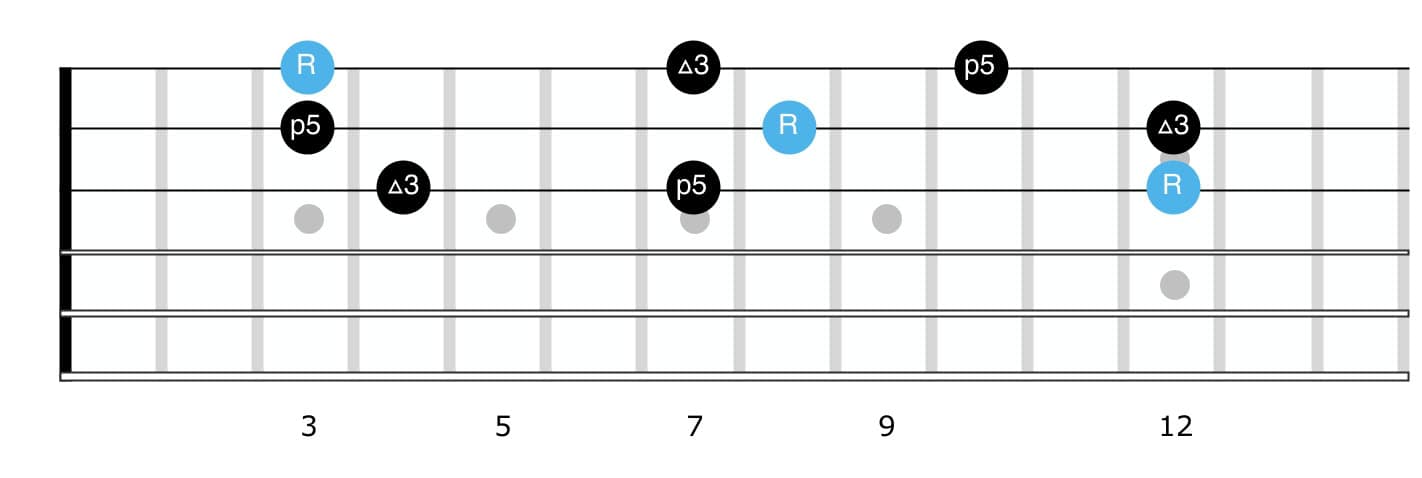
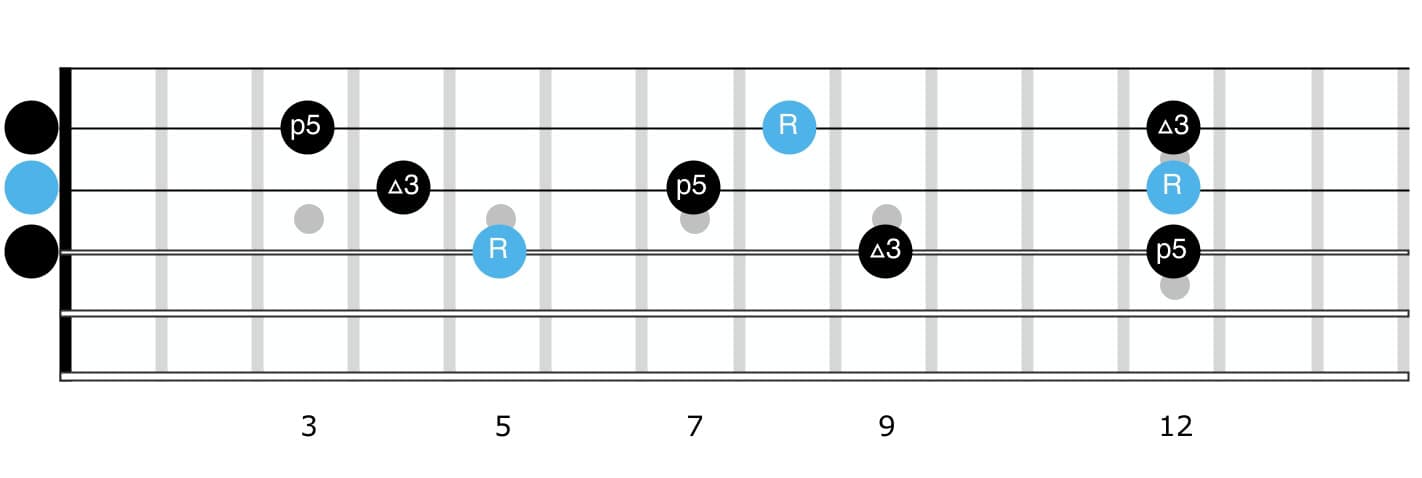
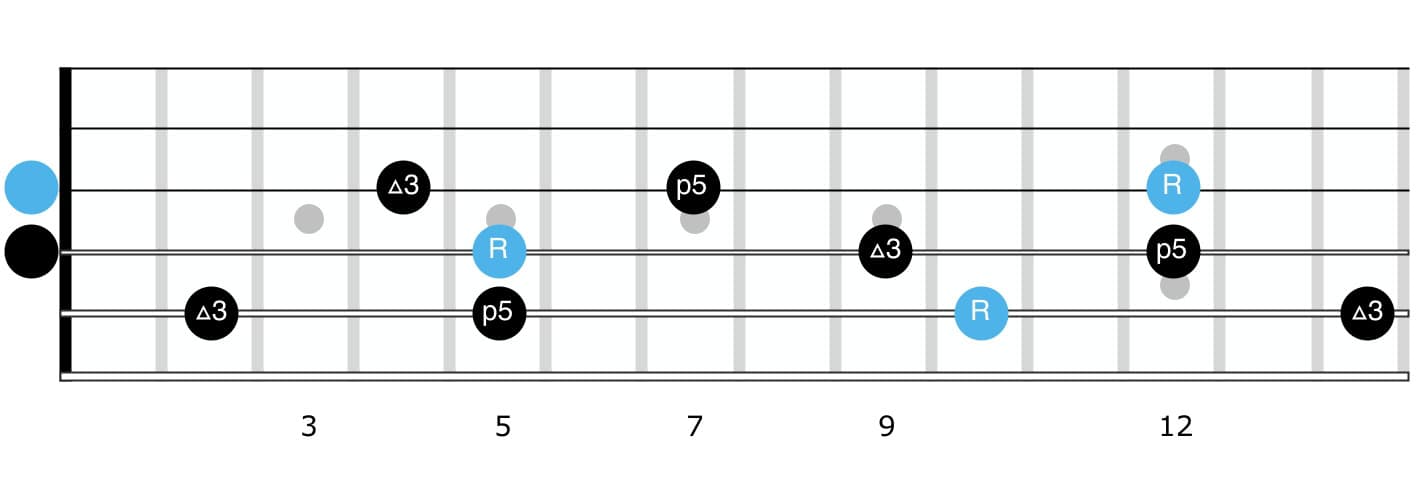
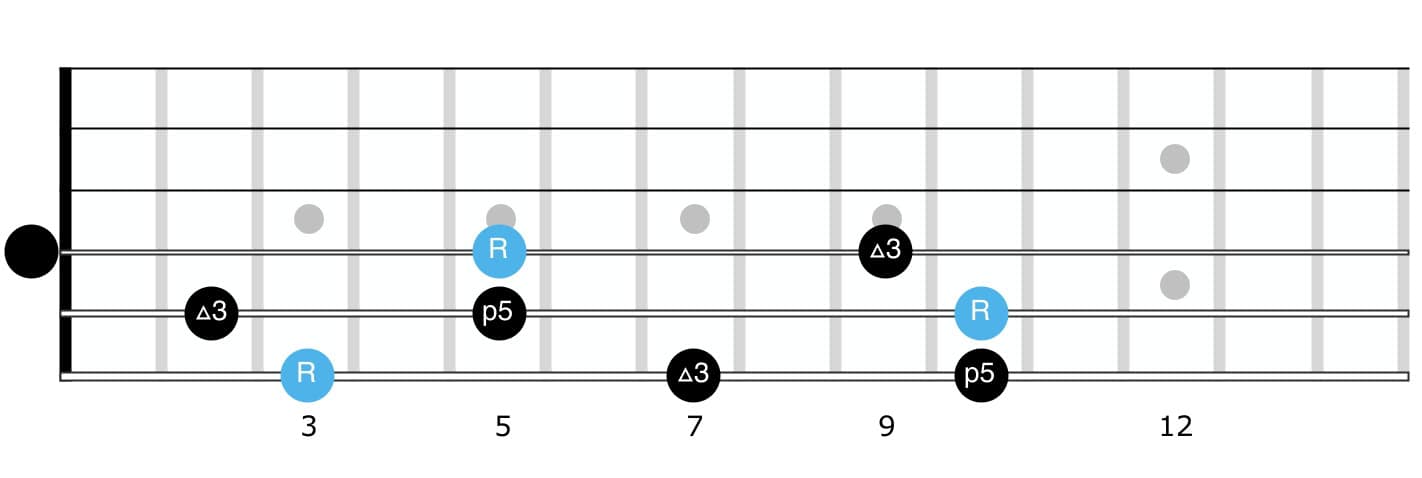
Relative Minor Triads
Minor Triads will fall on the 2nd, 3rd, and 6th degrees. The 6th being our Relative minor. In this case, A minor: A C E

A Minor Guitar Triads
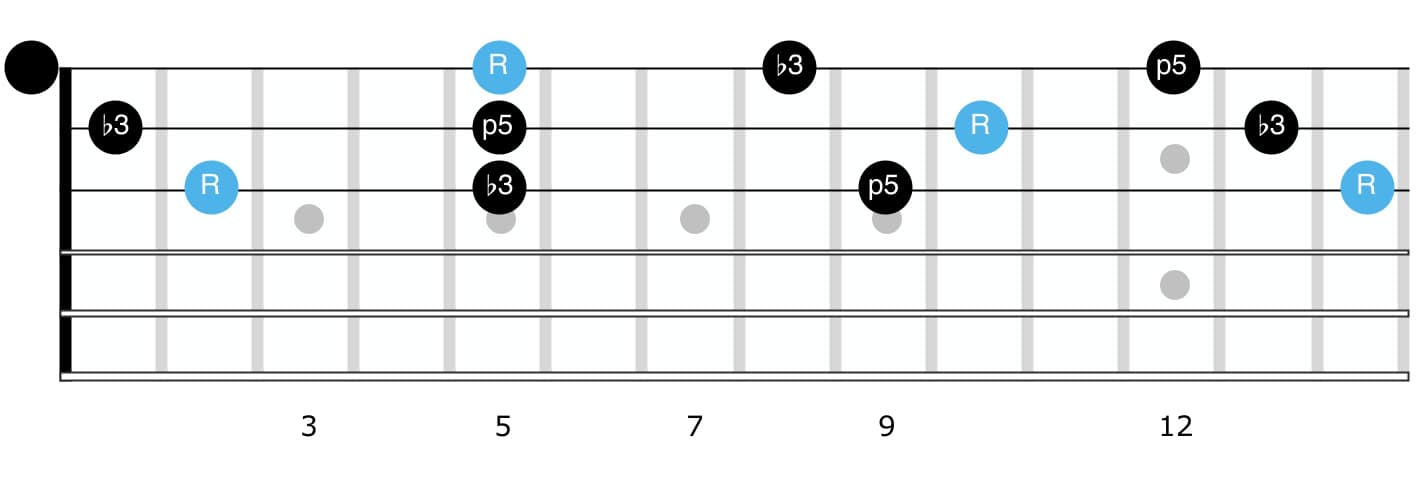
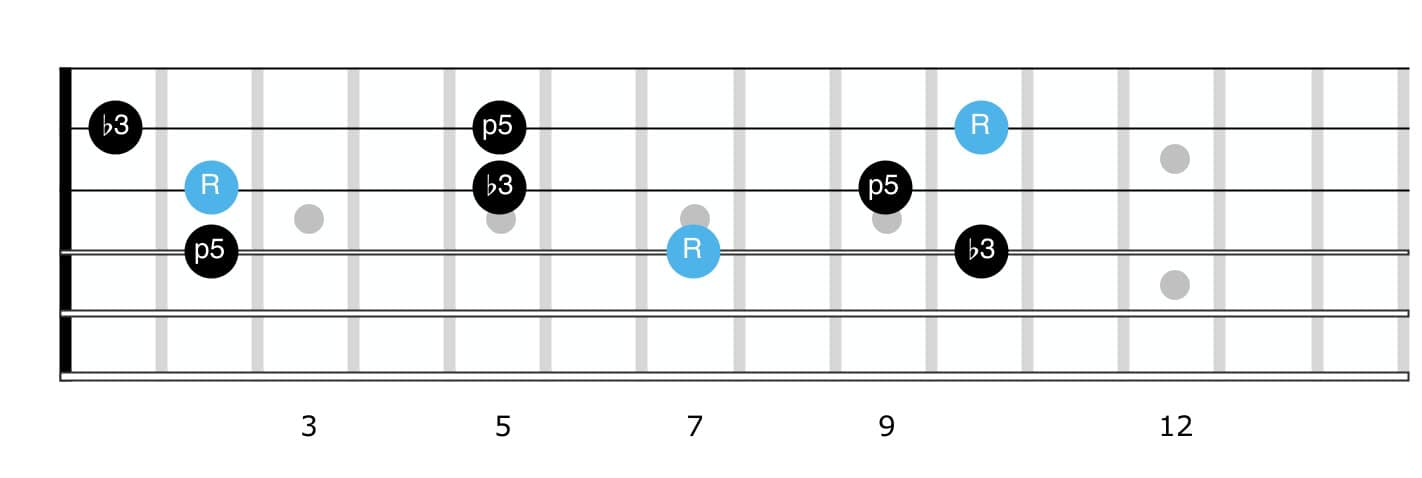
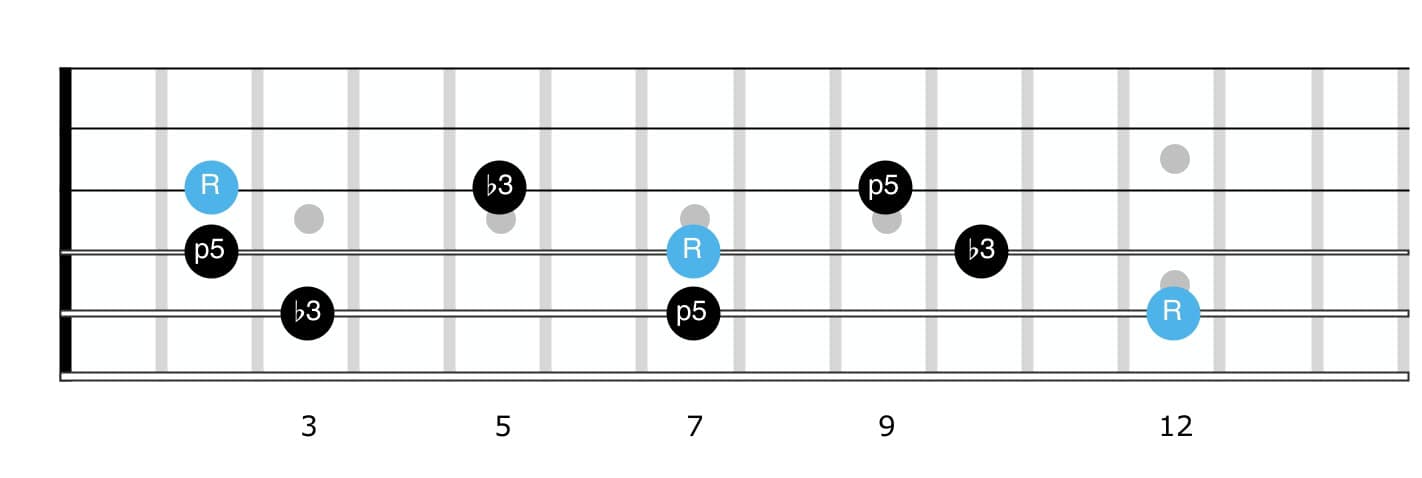
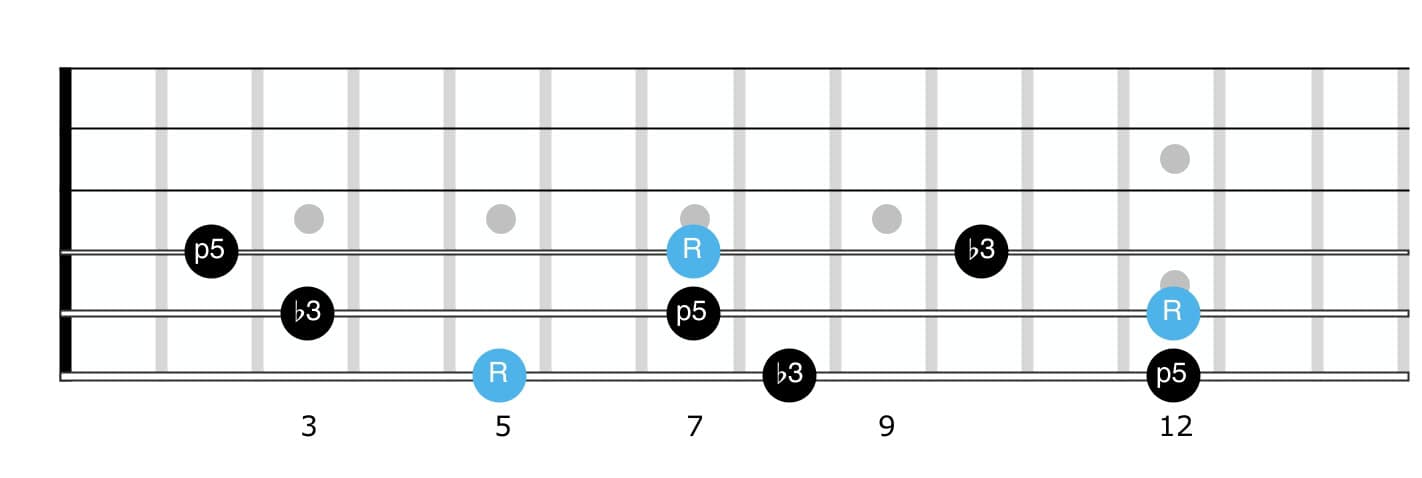
That’s all for minor triads in the Key of C.
Diminished Triads
Diminished triads are the odd guy in every Major Key. They fall on the last (7th) degree of the scale and sound wildly different then their Major, minor, or Augmented cousins. Diminished triads, chords, and arpeggios have a unique and dark flavor often heard in Classical, Jazz, and Metal guitar music.
Diminished chords and arpeggios really get fun when you add the 7th and start using them in improvisations and transitions to neighbor chords. I’ve written about this topic in some of my more advanced chord lessons and Chord book.
Let’s take a look at the B diminished triads in the Key of C Major.
B Diminished Guitar Triads
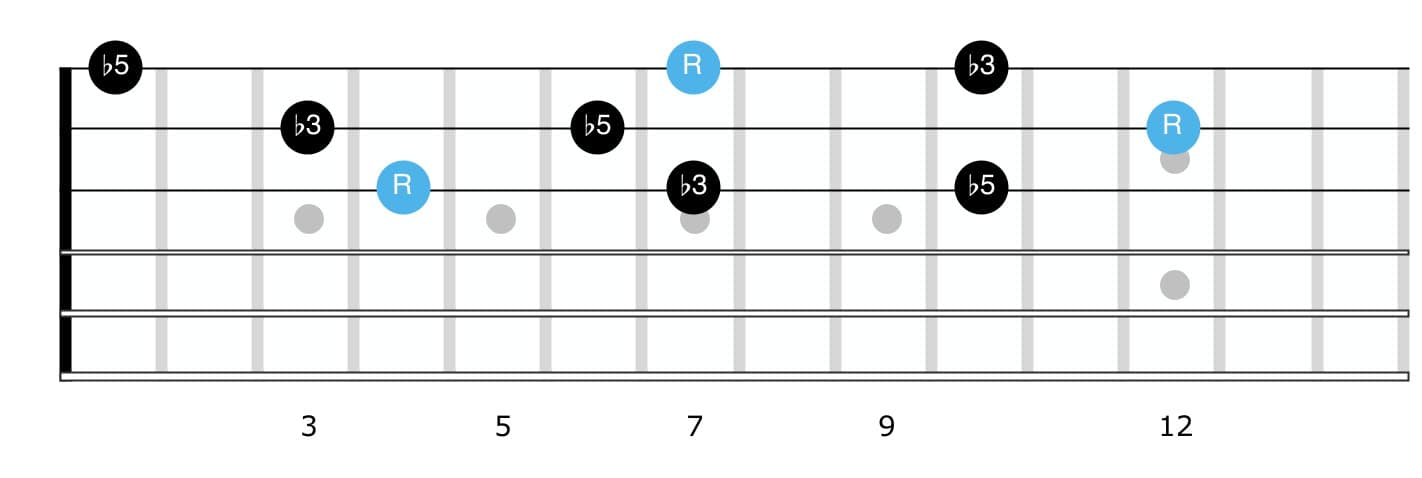
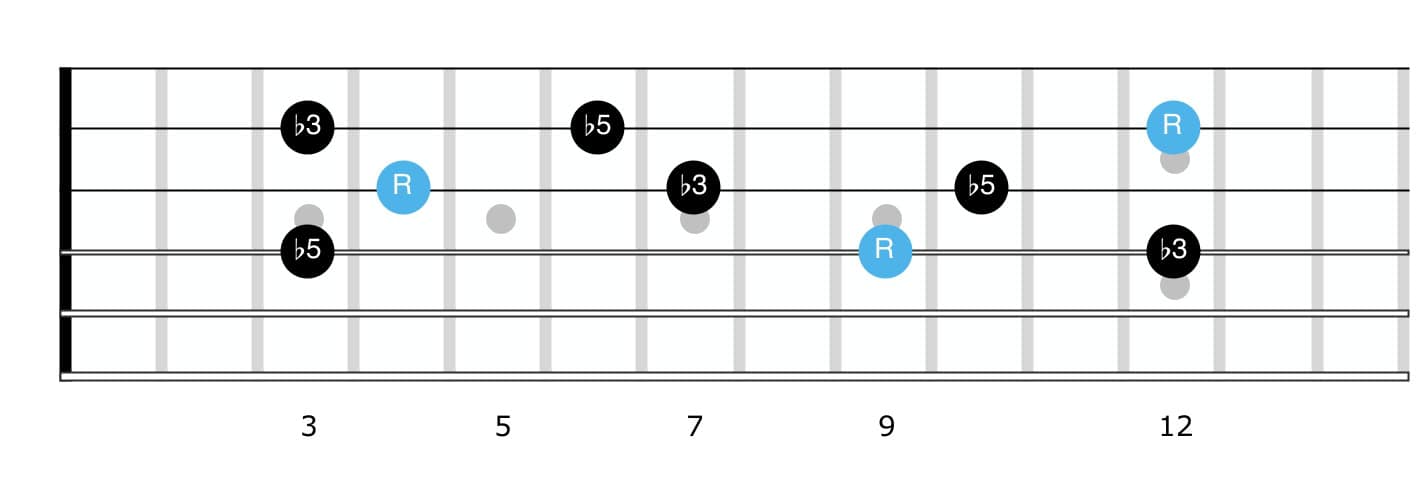
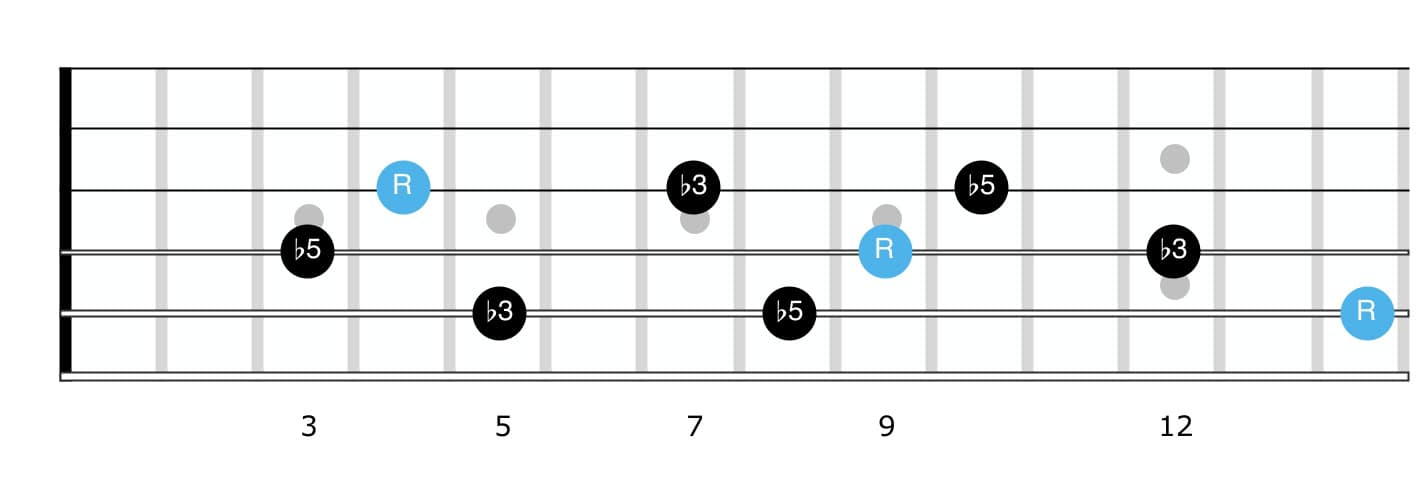
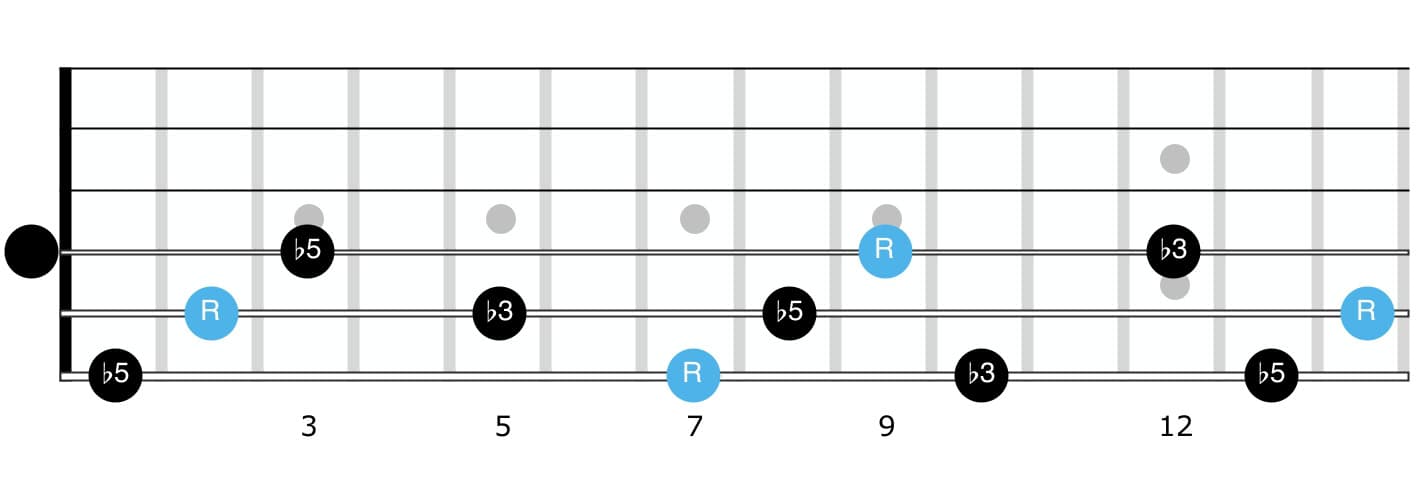
… and thats it for the Key of C Major. All of triads, all of the chord tones, all of the ‘good notes’ you need to create chords, melodies, and get some nice targeted inside sounding ideas for your solos and improvisations.
Working With More Guitar Triads – What’s Next?
- Solo Practice – Earlier I mentioned backing tracks and looping yourself playing simple chords. It really is a great way to get a handle on using these triads in a practical, musical way.
- Learning New Keys – Moving around the circle of keys or just randomly picking a new key is a great way to expand your fretboard knowledge and build an iron-clad structure for improvisation.
- Learn more Chords and Formulas – Learn more about how chords and arpeggios are formed by expanding your knowledge into 7th, 9th, 11th, and 13th chords as well as altered chords like Dom7#5 etc al.
As always you can always email me with any questions and I’ll be happy to help in any way I can.
Until next time,
Craig Smith
Craig Smith is a professional Guitarist, Teacher, and Writer living in Sanford, Florida. Craig has taught guitar lessons, performed 200+ gigs per year for nearly 30 years, and published 4 guitar instructional books. When he’s not gigging or writing, you may find him by the pool with his wife Celeste, 4 Chihuahuas, and a drink. 🎸

